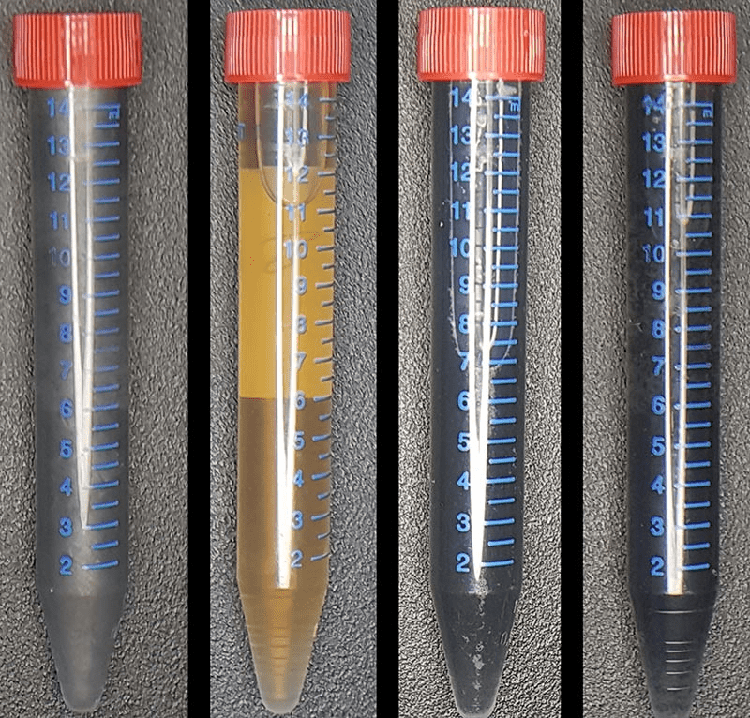Jul 11 2019
Scientists are turning to nanomaterials to develop new and more efficient medical devices, computers, and other sophisticated technologies.
 From left to right, A vial of graphite (Gr), like what you would find in an ordinary pencil; a vial of graphene oxide (GO), produced by exfoliating Gr—shedding the layers of the material—and mixing it with the bacteria Shewanella; a vial of the resulting product—graphene materials (mrGO); and a vial of graphene materials that have been produced chemically (crGO). The graphene materials produced by Anne Meyer’s lab are significantly thinner than the graphene materials produced chemically. (Image credit: Delft University of Technology photo / Benjamin Lehner)
From left to right, A vial of graphite (Gr), like what you would find in an ordinary pencil; a vial of graphene oxide (GO), produced by exfoliating Gr—shedding the layers of the material—and mixing it with the bacteria Shewanella; a vial of the resulting product—graphene materials (mrGO); and a vial of graphene materials that have been produced chemically (crGO). The graphene materials produced by Anne Meyer’s lab are significantly thinner than the graphene materials produced chemically. (Image credit: Delft University of Technology photo / Benjamin Lehner)
Nanomaterials are materials that are manipulated on the scale of molecules or atoms exhibiting exceptional properties. Graphene is a flake of carbon having a thickness of one layer of atoms. It is a groundbreaking nanomaterial because it can easily conduct electricity and also has remarkable flexibility and mechanical strength.
Conversely, it is difficult to produce graphene at a large scale and simultaneously retain its extraordinary properties, thus making it difficult to adopt this nanomaterial for day-to-day applications.
Anne S. Meyer, an associate professor of biology at the University of Rochester, and her coworkers at the Delft University of Technology in the Netherlands, described a method to overcome this drawback. The study has been reported in the ChemOpen journal.
The team demonstrated how an innovative technique can be used for producing graphene materials. In this method, oxidized graphite is mixed with bacteria. The new technique provides a time-saving, more economical, and eco-friendly way of creating graphene materials against those synthesized using chemical processes. This latest breakthrough can help in creating advanced medical equipment and computer technologies.
Graphene is obtained from graphite material, which can be found in a simple pencil. Despite having a thickness of single atom, graphene is the thinnest yet strongest 2D material known to scientists.
The 2010 Nobel Prize in Physics was awarded to researchers at the University of Manchester in the United Kingdom for their breakthrough discovery of graphene. However, the researchers’ approach of utilizing sticky tape to make graphene produced just a minimal amount of the material.
For real applications you need large amounts. Producing these bulk amounts is challenging and typically results in graphene that is thicker and less pure. This is where our work came in.
Anne S. Meyer, Associate Professor, Department of Biology, University of Rochester
Hence, to create larger amounts of graphene materials, Meyer and her coworkers began with a vial of graphite and eventually produced graphene oxide (GO) by exfoliating the graphite, that is, shedding the material layers. The researchers then mixed the GO with the bacteria Shewanella and allowed the beaker of precursor materials and bacteria to sit overnight. During this time, the GO was reduced to a graphene material by the bacteria.
“Graphene oxide is easy to produce, but it is not very conductive due to all of the oxygen groups in it,” Meyer stated. “The bacteria remove most of the oxygen groups, which turns it into a conductive material.”
In addition to being conductive, the bacterially-produced graphene material synthesized in Meyer’s laboratory is also thinner and more stable when compared to graphene created by chemical methods. In addition, it can also be stored for a longer duration of time, thus making it perfect for many different applications, including conducting ink and field-effect transistor (FET) biosensors.
FET biosensors are actually devices that are capable of detecting biological molecules and can be used for performing real-time glucose monitoring for diabetics, for instance.
“When biological molecules bind to the device, they change the conductance of the surface, sending a signal that the molecule is present,” Meyer stated. “To make a good FET biosensor you want a material that is highly conductive but can also be modified to bind to specific molecules.”
GO that has been reduced by bacteria can be said to be an ideal material because it is highly conductive and lightweight and, at the same time, it characteristically retains a minimal number of oxygen groups that can be used for binding to target molecules.
The graphene material produced through bacterial may also form the basis for conductive inks, which, in turn, could be used for making faster and more efficient circuit boards, computer keyboards, or tiny wires like those used to defrost the windshields of cars.
Conductive inks provide an “easier, more economical way to produce electrical circuits, compared to traditional techniques,” Meyer added. Conductive inks can even be used for making electrical circuits on top of non-conventional materials like paper or fabric.
Our bacterially produced graphene material will lead to far better suitability for product development. We were even able to develop a technique of ‘bacterial lithography’ to create graphene materials that were only conductive on one side, which can lead to the development of new, advanced nanocomposite materials.
Anne S. Meyer, Associate Professor, Department of Biology, University of Rochester